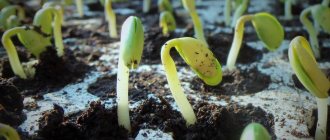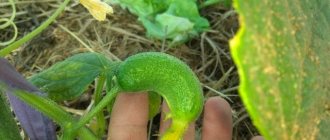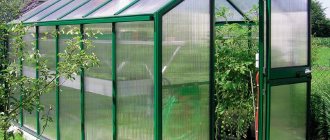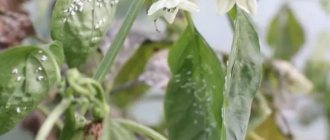Excessive humidity and, as a result, the appearance of condensation in a polycarbonate-based greenhouse is common and extremely common. And excessive air humidity can lead to serious problems, including crop loss.
There are several ways to deal with excess moisture accumulation in a greenhouse, and very often they need to be used in combination and not individually. That is, in most cases it will be necessary to apply several methods of control at once, otherwise the effectiveness of the work will be minimal or non-existent.
What is condensate and where does it come from?
Water, as everyone remembers from a school physics textbook, can be in three states: solid, liquid and gaseous. At the same time, she easily moves from one to another. Air contains water in the form of gas. The higher the temperature, the more water vapor. When the temperature begins to drop, water changes from a gaseous state to a more familiar state - liquid. This is how condensation forms. Thus, condensate is a product of the transition of a substance from gaseous to liquid form.
Perhaps the only place where condensation can bring joy is dewy grass. In all other cases, this is a problem. Today we will look at ways to get rid of condensation in greenhouses.
- Why do plastic windows sweat and is it possible to get rid of condensation?
We reveal the secrets of how to prevent condensation from collecting on the glass.
Ventilation devices
Existing ventilation systems can be divided into two types: mechanical and automatic. The first include doors and vents. The main advantage of such systems is that there is no need for extra costs on materials and equipment, since windows and vents must be present in any type of greenhouse design. However, it is worth considering that ventilation through vents and doors requires continuous monitoring. Without having time to open or close the door or windows in time, it is easy to either cook or overcool the plants. In addition, there is a high probability of drafts.
Prices for duct fans
Automatic ventilation systems are divided into several types.
- Electrical. In the simplest case, they are a fan connected through a thermostat. When the temperature rises to a certain level, the thermal relay contacts close and the fan starts working. The point is to create air circulation inside the greenhouse. Constantly mixing air masses will prevent rapid cooling near the walls and subsequent condensation. The advantages of forced ventilation are simplicity of design and elimination of the risk of drafts. The only downside is electricity costs.
Electric ventilation system in a greenhouse
Electric drive for greenhouse vents
Automatic ventilation scheme
Do-it-yourself automatic ventilation for a greenhouse from a bottle and a jar
When choosing this or another system for greenhouse ventilation, you should proceed from the principle of expediency. For a large greenhouse, it makes sense to use powerful electric drives for opening transoms, preferably factory-made. For an amateur gardener, it would be wise to use a simpler and more reliable energy-independent option.
Find out how to properly equip a greenhouse to get the most out of the structure from our new article - “Equipment for Greenhouses.”
In order not to worry about the appearance of condensation, a clear sign of problems with humidity inside the greenhouse, it is necessary to achieve the optimal combination of watering volumes and a temperature level sufficient for plant development. In addition, you should consider the ventilation system. Plants should not suffer from drafts, but the flow of fresh air should be sufficient to displace excess moisture.
Why does condensation appear in a greenhouse?
No matter what kind of greenhouse you build, you will still have to face this problem. To a greater or lesser extent, condensation will form both in a greenhouse made of polycarbonate and from ordinary film. There are several reasons for this phenomenon:
- At dawn, when the first rays of the sun hit the walls of your greenhouse, there is a large temperature difference between the air outside and inside the greenhouse. It is at this time that drops of water appear on the walls and ceiling.
- Plants, of course, are not people, but they also breathe. During respiration, they release carbon dioxide and water.
- Moisture evaporates from the leaves of plants and from the soil, which can also settle on the film or polycarbonate.
These harmless drops of water are dangerous for the inhabitants of greenhouses. Excess moisture contributes to the spread of various infections, which can cause diseases, and in more serious cases, the death of plants.
Where can I buy anti-cap film?
SPF "SHAR" offers hydrophilic films:
- “Svetlitsa” film is a high-strength frost-resistant film that is resistant to cracking, as well as to exposure to sunlight, wind and hail. It provides better illumination under the dome than conventional polyethylene. Serves for at least 7 years, has proven itself excellent both in small private farms and in large agricultural complexes.
- “Neva Premium” film is durable, resistant to mechanical damage a. Serves for at least 5 years and does not require removal for the winter. A profitable and economical solution.
How to get rid of condensation in a greenhouse?
It is not the problem that needs to be solved, but the reason that caused it. There are even several of them.
Problem 1 – lack of ventilation or its improper organization. The first condition in the fight against condensation is ventilation of the greenhouse. Vents - a necessary element of any greenhouse - help to establish air circulation and thereby reduce humidity. The best result is achieved when the transoms are located not only on the walls, but also on the ceiling of the building (unfortunately, this is extremely difficult to achieve in arched structures). The distance between them should not exceed 2-3 m, and the vents should be located at a height of 1 m. Ventilation should begin in the morning as soon as the difference in temperature inside and outside the greenhouse reaches 10°C, i.e. at an outside temperature of approximately 15°C.
It is not recommended to use doors for ventilation, because... In this case, cold air will move along the bottom of the greenhouse, which will negatively affect the condition of your green pets.
Problem 2 – incorrect fit. Dense thickets lead to stagnation of moisture. To get rid of them, you need to thin out the plantings from time to time and remove excess branches and leaves. The optimal density for planting is considered to be 3 plants per 1 sq.m.
Problem 3 – incorrect watering. Even experienced gardeners often do this basic and seemingly simplest method of caring for plants incorrectly. To avoid the appearance of water droplets in the greenhouse, watering should occur in the first half of the day. Otherwise, the greenhouse will not have time to ventilate, and the remaining moisture in the morning will cause increased condensation. The water used should be slightly warm.
The best irrigation system is point (drip). Firstly, it uses water (and, as a result, finances) very economically. Secondly, with this method, plants always receive only the right amount of liquid - this eliminates both excess and lack of moisture. With conventional watering, it is almost impossible to achieve such an effect.
- A few ideas on how to make drip irrigation at your dacha with your own hands
A drip irrigation system can be purchased at the store. But making it with your own hands is not much more difficult and much more interesting, and sometimes much cheaper.
Correction of temperature factors
The greenhouse, by design, accumulates heat, but sometimes there is too much of it. The following will help deal with excess to avoid condensation:
- Artificial shading of a greenhouse in hot weather. For this, special nets or ordinary branches are used.
- Planting shrubs near the building.
- Regular ventilation, even at night.
Advice. It is not advisable to use the door for ventilation. Cool air coming from below will damage the crop.
Normal temperature levels inside the greenhouse for most crops are:
- in the daytime - from +16 to +25 °C;
- at night - a little lower.
From spring to the peak of summer, heating is gradually brought up, as it happens under natural conditions for plants. Do not forget to monitor the heating of the soil. It can be the same temperature as air or slightly colder.
If you plan to grow a vegetable garden in cold weather, insulate the greenhouse to prevent condensation from forming. First, seal all holes and cracks with a good quality sealant. Then proceed with one of the measures:
- Cover the inside of the building with film. The material should not fit tightly to the ceiling and walls. A cushion is formed between it and the solid polymer. It will additionally retain the cold and protect against condensation.
- Place sheets of insulating material under the beds.
- Build a foundation to a depth of about 50 cm. Type - any.
- Heat the greenhouse to prevent condensation from accumulating inside. It is not necessary to choose electric or steam. There are cheaper alternatives. For example, bioheating. Just do not overheat the roots of the crops.
Several ways to reduce humidity
The following materials will help you cope with this problem:
- Mulch. Well-warmed soil should be covered with a layer of mulch (this can be either mowed lawn grass or, for example, peat). Mulching will prevent increased evaporation of moisture from the soil, which will reduce air humidity.
- The same effect can be achieved if you use film instead of mulch. Knowledgeable people recommend taking black film in this case. Due to its black color, which does not reflect the sun's rays, the film will heat up itself and thereby prevent overheating of the soil.
- Some gardeners put any covering material under the roof (transparent film, spunbond, etc.), thus trying to protect the plants from drops falling from above. This method has one significant drawback: by eliminating condensation, the “roof” will also rid the plantings of light.
Each gardener decides for himself which method of dealing with condensation suits him best. The main thing is to protect green pets from diseases.
Purpose of ventilation in winter
Winter ventilation performs the following functions:
- providing the greenhouse or winter garden with the necessary amount of fresh supply air so that plant crops feel comfortable and grow;
- removal of air exhausted by plants along with excess moisture generated from soil secretions and plants;
- drying, preventing the accumulation of condensation on the roof and walls of the structure due to the difference in external temperatures (summer, winter);
- cleaning the incoming air from dust, foreign matter, odors, etc.;
- normalization of the temperature indicator, which easily increases due to heating by sunlight (the glass warms up, respectively the floor, pieces of furniture, interior, which subsequently themselves become sources of excess heat).
Automatic control of the ventilation system allows you to:
- Autonomously regulate the temperature level in the room, without human assistance. turns on automatically when the upper standard threshold of the temperature parameter is crossed. Turns off when descending, also automatically;
- normalize air humidity. Moisture is necessary for plants, but its excess content in the air is an environment for the development of plant diseases, which slow down and prevent natural growth and development. This applies equally to greenhouses and winter gardens. Moreover, the required moisture content in the air makes it possible to reduce watering of plants, using only the drip method of soil moistening;
- automatically activate a valve that protects the ventilation system from precipitation;
- remotely control the ventilation system from anywhere, at the required time.
Automatic windows are not a solution
Nowadays, various options for automatic ventilators for greenhouses are offered. You can install openers for doors and standard vents, or you can install separately - in the roof or in the side - vents with automatic opening. These devices are undoubtedly useful. They make the work easier and help avoid steaming the plants if for some reason you forgot or were unable to open the greenhouse on time. But automatic openers or vents won’t help much with condensation. They are designed so that they open at a temperature of 18-24 °C. And by this time, condensation has already formed and will safely settle in droplets on the surface of the greenhouse.











